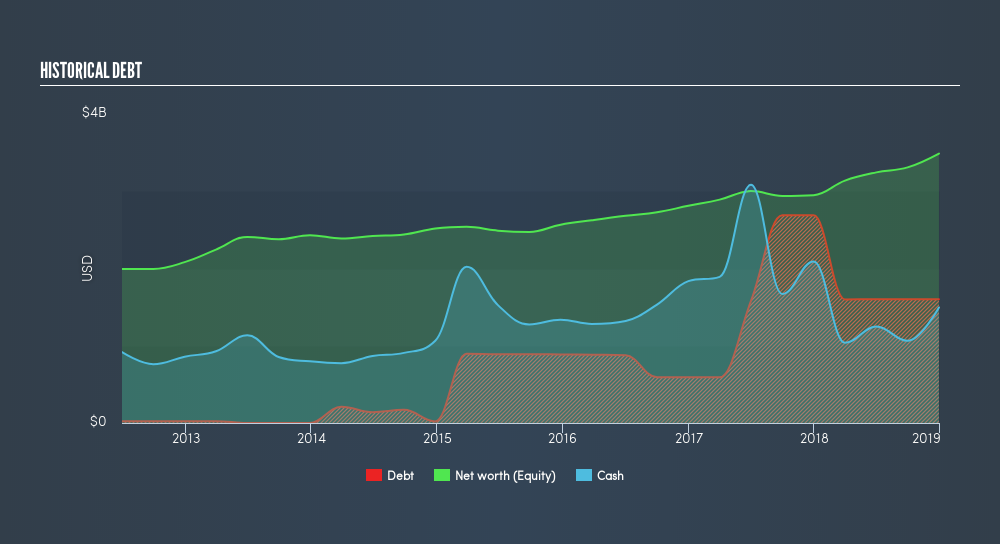- United States
- /
- Luxury
- /
- NYSE:TPR
What You Must Know About Tapestry, Inc.'s (NYSE:TPR) Financial Strength

Want to participate in a short research study? Help shape the future of investing tools and you could win a $250 gift card!
Small-cap and large-cap companies receive a lot of attention from investors, but mid-cap stocks like Tapestry, Inc. (NYSE:TPR), with a market cap of US$9.4b, are often out of the spotlight. While they are less talked about as an investment category, mid-cap risk-adjusted returns have generally been better than more commonly focused stocks that fall into the small- or large-cap categories. TPR’s financial liquidity and debt position will be analysed in this article, to get an idea of whether the company can fund opportunities for strategic growth and maintain strength through economic downturns. Don’t forget that this is a general and concentrated examination of Tapestry’s financial health, so you should conduct further analysis into TPR here.
View our latest analysis for Tapestry
TPR’s Debt (And Cash Flows)
Over the past year, TPR has reduced its debt from US$2.7b to US$1.6b – this includes long-term debt. With this debt repayment, TPR currently has US$1.5b remaining in cash and short-term investments to keep the business going. Additionally, TPR has produced cash from operations of US$1.2b in the last twelve months, resulting in an operating cash to total debt ratio of 73%, indicating that TPR’s debt is appropriately covered by operating cash.
Can TPR pay its short-term liabilities?
At the current liabilities level of US$1.1b, the company has maintained a safe level of current assets to meet its obligations, with the current ratio last standing at 2.62x. The current ratio is calculated by dividing current assets by current liabilities. For Luxury companies, this ratio is within a sensible range as there's enough of a cash buffer without holding too much capital in low return investments.

Is TPR’s debt level acceptable?
With debt reaching 46% of equity, TPR may be thought of as relatively highly levered. This is not unusual for mid-caps as debt tends to be a cheaper and faster source of funding for some businesses. We can check to see whether TPR is able to meet its debt obligations by looking at the net interest coverage ratio. A company generating earnings before interest and tax (EBIT) at least three times its net interest payments is considered financially sound. In TPR's, case, the ratio of 15.66x suggests that interest is comfortably covered, which means that lenders may be less hesitant to lend out more funding as TPR’s high interest coverage is seen as responsible and safe practice.
Next Steps:
Although TPR’s debt level is towards the higher end of the spectrum, its cash flow coverage seems adequate to meet obligations which means its debt is being efficiently utilised. Since there is also no concerns around TPR's liquidity needs, this may be its optimal capital structure for the time being. This is only a rough assessment of financial health, and I'm sure TPR has company-specific issues impacting its capital structure decisions. You should continue to research Tapestry to get a more holistic view of the mid-cap by looking at:
- Future Outlook: What are well-informed industry analysts predicting for TPR’s future growth? Take a look at our free research report of analyst consensus for TPR’s outlook.
- Valuation: What is TPR worth today? Is the stock undervalued, even when its growth outlook is factored into its intrinsic value? The intrinsic value infographic in our free research report helps visualize whether TPR is currently mispriced by the market.
- Other High-Performing Stocks: Are there other stocks that provide better prospects with proven track records? Explore our free list of these great stocks here.
We aim to bring you long-term focused research analysis driven by fundamental data. Note that our analysis may not factor in the latest price-sensitive company announcements or qualitative material.
If you spot an error that warrants correction, please contact the editor at editorial-team@simplywallst.com. This article by Simply Wall St is general in nature. It does not constitute a recommendation to buy or sell any stock, and does not take account of your objectives, or your financial situation. Simply Wall St has no position in the stocks mentioned. Thank you for reading.
About NYSE:TPR
Tapestry
Provides luxury accessories and branded lifestyle products in North America, Greater China, rest of Asia, and internationally.
Average dividend payer and fair value.
Similar Companies
Market Insights
Community Narratives





